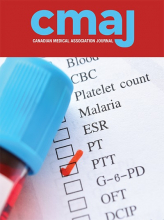International normalized ratio (INR) and activated partial thromboplastin time (aPTT) have limited clinical utility
The INR and aPTT should be used only for specific clinical indications (see Appendix 1, available at www.cmaj.ca/lookup/doi/10.1503/cmaj.220629/tab-related-content).1
Bleeding history is the most important predictor of an inherited bleeding disorder
The INR and aPTT have poor sensitivity (1.0%–2.1%) for bleeding disorders. 1 Clinicians considering an inherited bleeding disorder should first use a Bleeding Assessment Tool (BAT).2 A negative BAT score has a sensitivity approaching 100% to rule out von Willebrand disease (the most common inherited bleeding disorder).2 A positive BAT score should prompt referral to a hematologist for consideration of specialized coagulation testing.1
International normalized ratio and aPTT testing are not indicated before low-risk surgery or interventional radiology
Abnormal INR or aPTT results are not associated with an increased bleeding risk in the setting of low-risk procedures.3,4 An abnormal result with no bleeding history or anticoagulant use should be repeated to rule out artifact or sample handling error. Investigation is generally not indicated for an aPTT of less than 4 seconds above the upper limit of normal.2
An abnormal INR or aPTT in a patient who is bleeding suggests a potential medical emergency
Actionable causes of bleeding such as anticoagulant use, severe liver disease or acquired hemophilia may be indicated by the elevated INR or aPTT, respectively.5
Clinical history and drug pharmacokinetics are more important than INR or aPTT results in guiding clinical decision-making in patients taking direct oral anticoagulants (DOACs)
Direct oral anticoagulants variably and inconsistently affect INR and aPTT results. If a patient is bleeding, decisions on the use of a reversing blood product or drug should be based on the last reported drug dose, renal function and pharmacokinetics. In some centres, DOAC-calibrated assays are available to evaluate the presence of clinically relevant drug activity.6
Footnotes
Competing interests: None declared.
This article has been peer reviewed.
This is an Open Access article distributed in accordance with the terms of the Creative Commons Attribution (CC BY-NC-ND 4.0) licence, which permits use, distribution and reproduction in any medium, provided that the original publication is properly cited, the use is noncommercial (i.e., research or educational use), and no modifications or adaptations are made. See: https://creativecommons.org/licenses/by-nc-nd/4.0/











